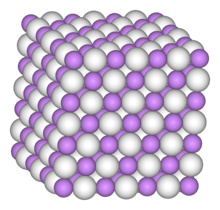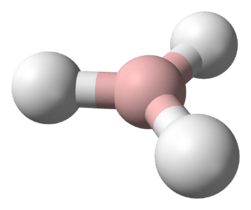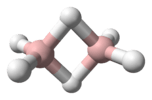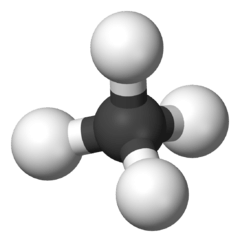Sulfanyl
Sulfanyl (HS•), also known as the mercapto radical, hydrosulfide radical, or hydridosulfur, is a simple radical molecule consisting of one hydrogen and one sulfur atom. The radical appears in metabolism in organisms as H2S is detoxified. Sulfanyl is one of the top three sulfur-containing gasses in gas giants such as Jupiter and is very likely to be found in brown dwarfs and cool stars. It was originally discovered by Margaret N. Lewis and John U. White at the University of California in 1939.[4] They observed molecular absorption bands around 325 nm belonging to the system designated by 2Σ+ ← 2Πi. They generated the radical by means of a radio frequency discharge in hydrogen sulfide.[5] HS• is formed during the degradation of hydrogen sulfide in the atmosphere of the Earth. This may be a deliberate action to destroy odours or a natural phenomenon.[6]
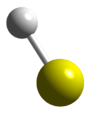 | |
| Names | |
|---|---|
| Systematic IUPAC name | |
| Other names
λ1-Sulfane[2] | |
| Identifiers | |
3D model (JSmol) |
|
| ChEBI | |
| ChemSpider | |
| 299 | |
PubChem CID |
|
| |
| |
| Properties | |
| HS• | |
| Molar mass | 33.073 g mol−1 |
| Appearance | Yellow gas[3] |
| Reacts | |
| Thermochemistry | |
Std molar entropy (S |
195.63 J K−1 mol−1 |
Std enthalpy of formation (ΔfH⦵298) |
139.33 kJ mol−1 |
| Related compounds | |
Related radicals |
Hydroxyl |
Related compounds |
Hydrogen sulfide |
Except where otherwise noted, data are given for materials in their standard state (at 25 °C [77 °F], 100 kPa). | |
| Infobox references | |
The organic analogue of sulfanyl is thiyl radical with the formula RS., where R = alkyl or aryl.
Natural occurrence
Absorption lines of sulfanyl in space were first detected in the infrared by Yamamura (2000) in a star R And. In the sun •SH was detected at several ultraviolet wavelengths: 326.0459, 327.5468, 328.9749, 330.0892 and 330.1112 nm.[7]
Sulfanyl has been detected in interstellar gas,[8] and it is possibly present in comets.[9]
Various theoretical studies have examined HS• in atmospheres. In Earth's atmosphere HS• reacts with NO2 to make two products HSNO2 and HSONO. HSONO decomposes to HSO and NO. HS• also reacts with O2 and N2O.[10] HS• can also react with Cl2 producing HSCl and a Cl• atom.[11] HS• destroys ozone producing HSO• and oxygen.[12] HS• is formed in the Earth's atmosphere by the reaction of HO•, the hydroxyl radical, on carbon disulfide, carbon oxysulfide and hydrogen sulfide with side products of carbon dioxide and water. Photodissociation of hydrogen sulfide also produces the radical in air.[13]
In a planetary atmosphere that contains H2S, HS• will be formed if the temperature and pressure are high enough. The ratio of H2S and HS• is given by:
- log(XH2S/XHS) = −3.37 + 8785/T + 0.5 log PT + 0.5 log XH2
For a hydrogen dominated atmosphere in a gas giant or star: H2S has the same level as HS• at
- .
At higher temperatures HS• breaks up into sulfur vapour and H2. The line of equal S and HS concentration follows the line
- .
The lines of equal concentration cross at 1509 K and 1.51 Pa, with HS• being left out of the mix at lower temperatures and pressures. •SH is expected to be the second or third most common sulfur containing gas in gas giants or brown dwarfs.[14]
Formation
Thermal decomposition of mercaptans, such as ethyl mercaptan yields HS•.[15]
The radical can be formed by the action of ultraviolet radiation on hydrogen sulfide, which splits off a hydrogen atom. A wavelength of 190 nm gives maximum absorption.[16]
In humans superoxide dismutase [Cu-Zn] converts the hydrosulfide ion (HS−) to HS•. This happens as the Cu2+ ion in the enzyme is converted to Cu+.[17]
Sulfide dehydrogenase as found in sulfur bacteria catalyses the oxidation of HS− to HS•, by removing a single electron.[18]
When sulfur minerals are leached with ferric ions HS• is formed in this way:
- MS + Fe3+ + 2H+ → M2+ + Fe2+ + H2S•+
with the H2S•+ radical then passing a proton to water to make the HS• radical. M is a metal such as zinc or copper.[19] This has potential for bioleaching in metallic ore extraction.
The hydrosulfide ion HS− can be oxidized to HS• with cerium (IV) sulfate.[20]
Reactions
Being a radical, HS• is quite reactive. In water HS can react with O2 producing SO2− and H+. SO2− reacts further with O2 to make SO2 and superoxide O2−. In water HS• has an equilibrium with S− • and H+. The hydroxyl radical •OH combines with H2S to form HS• and water.[21] Other reactions investigated by Tiee (1981) are HS• + ethylene, HS• + O2 → HO• + SO, and reactions with itself HS• + HS• → H2S2 or H2 and S.[22] The disulfide can further react with HS• to make the disulfide radical HS–S• and H2S.[19]
Properties
The ionization energy of HS is 10.4219 eV.[23] The reduction potential to go to HS− is 0.92 eV.[24] HS• in water can ionize to S•− and H+. The S•− can catalyze a cis-trans conversion in lipids.[25]
The interatomic distance between sulfur and hydrogen in the radical is 0.134 nm.[26]
HS• reacts with carboxylic acids to make carbonyl sulfide (COS) and probably is the main source of this substance in the atmosphere of Earth.[20]
Related molecules
HS—S• is called disufanyl with lengthening chains as trisulfanyl, tetrasulfanyl and pentasulfanyl HSSSSS•. S−* is termed sulfanidyl. HS+ is known as sulfanylium, and the common hydrosulfide ion HS− is also known as sulfanido for a ligand or sulfanide as an anion. Further down the periodic table, HSe• is known as selanyl, and HTe• is termed tellanyl.
References
- "sulfanyl (CHEBI:29312)". Chemical entities of biological interest. UK: European Bioinformatics Institute. 6 November 2006. Main. Retrieved 8 October 2011.
- "Mercapto radical – Compound summary". PubChem Compound. USA: National Center for Biotechnology Information. 16 September 2004. Identification and related records. Retrieved 12 October 2011.
- Zahnle, Kevin; Mark S. Marley; R. S. Freedman; K. Lodders; J. J. Fortney (26 June 2009). "Atmospheric sulfur photochemistry on hot Jupiters". The Astrophysical Journal. 701 (1): L20–L24. arXiv:0903.1663v2. Bibcode:2009ApJ...701L..20Z. doi:10.1088/0004-637X/701/1/L20.
- Lewis, Margaret; John U. White (1939). "The band spectrum of HS". Physical Review. 55 (10): 894–898. Bibcode:1939PhRv...55..894L. doi:10.1103/PhysRev.55.894.
- Harrison, Jeremy J.; Bryce E. Williamson (November 2005). "Magnetic circular dichroism of the mercapto radical in noble-gas matrices" (PDF). Journal of the Indian Institute of Science. 85: 391–402.
- Mercado-Cabrera, Antonio; B. Jaramillo-Sierra; S.R. Barocio; R. Valencia-Alvarado; M. Pacheco-Pacheco; R. Peña-Eguiluz; R. Lopez-Callejas; A. Muñoz-Castro; A. De la Piedad-Beneitez (29 April 2009). "Environmental odour control by atmospheric dielectric barrier discharge" (PDF). ISPC. Retrieved 20 October 2011.
- Sveta V. Berdyugina & W.C. Livingston (May 2002). "Detection of the mercapto radical SH in the solar atmosphere". Astronomy and Astrophysics. 387: L6–L9. Bibcode:2002A&A...387L...6B. doi:10.1051/0004-6361:20020364.
- Palca, Joe (1 October 2011). "Flying telescope makes an out-of-this-world find". NPR. Retrieved 8 October 2011.
- "The cosmic ice laboratory – Cometary molecules".
- Resende, Stella M. (2007). "The atmospheric oxidation of the HS radical: Reaction with NO2". Journal of Atmospheric Chemistry. 56 (1): 21–32. Bibcode:2006JAtC...56...21R. doi:10.1007/s10874-006-9040-z.
- Resende, Stella M.; Fernando R Ornellas (25 February 2000). "Atmospheric reaction between the HS radical and chlorine". Chemical Physics Letters. 318 (4–5): 340–344. Bibcode:2000CPL...318..340R. doi:10.1016/S0009-2614(00)00019-1.
- Yoshimura, Yasunori; Toshio Kasai, Hiroshi Ohoyama and Keiji Kuwata; Ohoyama, Hiroshi; Kuwata, Keiji (1995). "Nascent HF + and HSO(2A') formations in the elementary reactions of F + H2S and HS + O3 and the internal energy distributions". Canadian Journal of Chemistry. 73 (2): 204–221. doi:10.1139/v95-029.
- Furones, Maikel Yusat Ballester (2008). "A theoretical study on the HSO2 molecular system" (PDF). Coimbra: Universidade de Coimbra. pp. 1, 37. Retrieved 20 October 2011.
- Visscher, Channon; Katharina Lodders , and Bruce Fegley, Jr.; Fegley, Bruce (10 September 2006). "Atmospheric chemistry in giant planets, brown dwarfs, and low-mass dwarf stars. II. Sulfur and phosphorus". The Astrophysical Journal. 648 (2): 1181–1195. arXiv:astro-ph/0511136. Bibcode:2006ApJ...648.1181V. doi:10.1086/506245.CS1 maint: multiple names: authors list (link)
- Sehon, A. H.; B. deB. Darwent (October 1954). "The thermal decomposition of mercaptans". Journal of the American Chemical Society. 76 (19): 4806. doi:10.1021/ja01648a011.
- Hollaender, Alexander; Livingston, Robert (1955). "1". Radiation Biology. McGraw Hill. p. 27.
- Lyons, Thomas J.; Edith Butler Gralla; Joan Selverstone Valentine (1999). Biological chemistry of copper-zinc superoxide dismutase and its link to amyotrophic lateral sclerosis (PDF). Metal ions in biological systems. Basel, Switzerland: Marcel Decker Inc. p. 139. ISBN 978-0-8247-1956-2. Retrieved 10 October 2011.
- Sorokina, Dimitry Yu; Govardus A.H de Jong; Lesley A. Robertson; Gijs J. Kuenen (1 May 1998). "Purification and characterization of sulfide dehydrogenase from alkaliphilic chemolithoautotrophic sulfur-oxidizing bacteria". FEBS Letters. 427 (1): 11–14. doi:10.1016/S0014-5793(98)00379-2. PMID 9613590.
- Schippers, Axel; Wolfgang Sand (January 1999). "Bacterial leaching of metal sulfides proceeds by two indirect mechanisms via thiosulfate or via polysulfides and sulfur" (PDF). Applied and Environmental Microbiology. 65 (1): 319–321. PMC 91023. PMID 9872800.
- Pos, Willer H.; Daniel D. Riemer; Rod G. Zika (1998). "Carbonyl sulfide (OCS) and carbon monoxide (CO) in natural waters: evidence of a coupled production pathway". Marine Chemistry. 62 (1–2): 89–101. doi:10.1016/S0304-4203(98)00025-5.
- Fang, Hao Jie; Dong Wen Bo, Zhang Ren Xi and Hou, Hui Qi (June 2006). "水相中·HS 的光谱表征及其与氧气的反应研究" [Spectrum of•HS and its reactions with oxygen in aqueous solution]. Acta Physico-Chimica Sinica (in Chinese). 22 (6): 761–763. doi:10.3866/PKU.WHXB20060623. Retrieved 12 October 2011.CS1 maint: multiple names: authors list (link)
- Tiee, J.J. (1981). "Spectroscopy and reaction kinetics of HS radicals". Kinetics Database. NIST. 82 (1): 80–84. Bibcode:1981CPL....82...80T. doi:10.1016/0009-2614(81)85111-1. Retrieved 13 October 2011.
- Cheng, B. M.; E. P. Chew, W. C. Hung, J. Eberhard and Y. P. Lee; Hung, Wen-Ching; Eberhard, Jürg; Lee, Yuan-Pern (May 1998). "Photoionization studies of sulfur radicals and products of their reactions" (PDF). Journal of Synchrotron Radiation. 5 (3): 1041–3. doi:10.1107/S0909049597016075. PMID 15263738.CS1 maint: multiple names: authors list (link)
- Das, T. N.; R. E. Huie; P. Neta; S. Padmaja (11 June 1999). "Reduction potential of the sulfhydryl radical: pulse radiolysis and laser flash photolysis studies of the formation and reactions of •SH and HS–SH•− in aqueous solutions". The Journal of Physical Chemistry A. 103 (27): 5221–5226. Bibcode:1999JPCA..103.5221D. doi:10.1021/jp9907544.
- Lykakis, Ioannis N.; Carla Ferreri; Chryssostomos Chatgilialoglu (19 January 2007). "The sulfhydryl radical (HS•/S•−): A contender for the isomerization of double bonds in membrane lipids". Angewandte Chemie. 46 (11): 1914–1916. doi:10.1002/anie.200604525. PMID 17450618.
- Ellingson, Benjamin A.; Donald G. Truhlar (1 August 2007). "Explanation of the unusual temperature dependence of the atmospheric important •OH + H2S → H2O + •SH reaction and prediction of the rate constant at combustion temperatures" (reprint). J. Am. Chem. Soc. 129 (42): 12765–12771 [12769]. doi:10.1021/ja072538b. PMID 17910447. Retrieved 20 October 2011.
External links
- Mercapto radical from NIST
- Milan, J. B.; W. J. Buma; C. A. de Lange (22 October 1996). "Two-photon resonance enhanced multiphoton ionization photoelectron spectroscopy of the SH (SD) radical below and above the lowest ionization threshold". Journal of Chemical Physics. 105 (16): 6688–6712. Bibcode:1996JChPh.105.6688M. doi:10.1063/1.471850. Retrieved 11 October 2011.
- Burma, W.J.; J. B. Milan; C.A. de Lange; C. M. Western.; N.M.R. Ashfold (1995). "Two-photon resonance enhanced MPI-PES above the lowest ionization threshold: observation of the [a E1delta]5p pi E2phi state of the SH (SD) radical". Chemical Physics Letters. 239 (4–6): 326–331. Bibcode:1995CPL...239..326M. doi:10.1016/0009-2614(95)00488-P.
- Nourbakhsh, Omid (August 2015). Manipulation of the motion of polyatomic molecules by AC and DC Stark deceleration (PDF) (Thesis). Vancouver: THE UNIVERSITY OF BRITISH COLUMBIA. Sulfur deuteride radical SD• microwave spectrum

